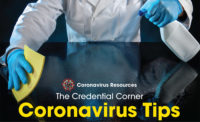The COVID Standard of Care

Tens of thousands of U.S. businesses are gearing up to reopen after being closed down for months, but do they really need to hire a professional to perform deep disinfection services prior to reopening? Understanding the virus and its ability to maintain infectious properties on various surfaces is important to answer this question. Global health agencies indicate the SARS-CoV-2 (2019 Coronavirus) does not maintain infectious properties beyond five days on interior surfaces; therefore buildings that have been unoccupied for months should be considered low risk for exposure.
It is reasonable to recommend that low risk properties can be deep cleaned using traditional janitorial/custodial procedures without COVID-specific applications. However, some building owners or employers are getting lured into hiring disinfection companies to perform COVID-related disinfection services to provide the illusion that the building is now “safe” to enter. If disinfection services are being performed properly, they are only effective at that moment in time and could easily be re-contaminated five minutes later when an infected employee or the public enter the building. Often, it seems this one-time cleaning and disinfection is nothing more than a psychological play to appease employees and/or the public to feel safe while inside that building.
Honestly, having COVID-certified professionals clean and disinfect buildings isn’t necessarily the hard part, although we are constantly seeing untrained, uninsured contractors not utilizing protocols to apply chemicals that are ineffective and in many cases providing a false sense of security. The bigger and more difficult question is how do we maintain the overall building hygiene at the highest possible level to control and prevent the exposure of COVID-19 to employees and the public after businesses reopen.
Maintenance & Prevention
This maintenance and prevention process is not being mentioned or discussed by government officials or COVID service professionals and is the most important process in preventing a second wave of infections and a potentially bigger economic collapse for U.S. businesses. Social distancing orders may be helping to flatten the curve as summer progresses. However, in order to revive the U.S. economy and keep employees and the public safe, the “new normal” is following a COVID Standard of Care. Imagine going to the dentist for a routine deep cleaning once every six months, but not performing daily brushing, flossing, or any kind of mouth-care between dental visits. The lack of routine procedural cleaning and increased building hygiene by all employees will be like not brushing or flossing your teeth for six months.

Elements of the Standard of Care include, but are not limited to the following:
COVID Training andCertification
Most contractors do not have any form COVID training as required by OSHA and, in some cases, insurance carriers. According to OSHA, employers must “train all workers with reasonably anticipated occupational exposure to SARS-CoV-2 about the sources of exposure to the virus, the hazards associated with that exposure, and appropriate workplace protocols in place to prevent or reduce the likelihood of exposure.” Reasonable exposure to SARS-CoV-2 includes virtually every industry on earth.
Disinfection Protocols
According to OSHA, employer protocols must be developed to prevent or reduce the likelihood of exposure to SARS-CoV-2. Protocols should include control and prevention measures, response procedures on what to do if an employee tests positive for COVID-19, the use of PPE, engineering controls, and administrative controls (work practices). Consider these standards:
- PPE (29 CFR 1910.132)
- Eye and face protection (29 CFR 1910.133)
- Hand protection (29 CFR 1910.138)
- Respiratory protection (29 CFR 1910.134)
Protocols will also be the document used to assist with the cleanup procedures and determine the level of risk associated with that particular facility/building.
Employers should also ensure that employees have obtained COVID-specific training and implement routine increased cleaning and hygiene for the building. COVID-specific health and safety requirements should be performed and documented as required by OSHA.
Liability & Legal Considerations
Contractors performing COVID services should be properly insured with a “Communicable Disease Coverage Endorsement” added to their Pollution Liability section of their Environmental Liability Policy. Most policies have a communicable disease or virus exclusion in their policy.
In addition, a company that is insured/rated as janitorial services would want to notify their insurer of the change in exposure to avoid potential claims. They should notify their broker/insurer that they will be taking on biohazard work.

Compliance with these items will result in the building owner or employer acquiring a COVID-compliant placard that can be displayed on the front of the window of the building. This placard will visually demonstrate that best available practices and procedures are being implemented to control and prevent exposure to COVID-19.
Contractors should also use a COVID service legal contract prepared by an experienced attorney to ensure the highest liability protection with clear expectations on the services to be performed. Many contracts are not properly designed for COVID-related services and could lead to increased liability to the contractor.
Without a recognized COVID Standard of Care, we will never achieve consistent results. A lack of Standard will also lead to a false sense of security for employers and consumers which could lead to more infections and another catastrophic economic collapse.
Looking for a reprint of this article?
From high-res PDFs to custom plaques, order your copy today!






